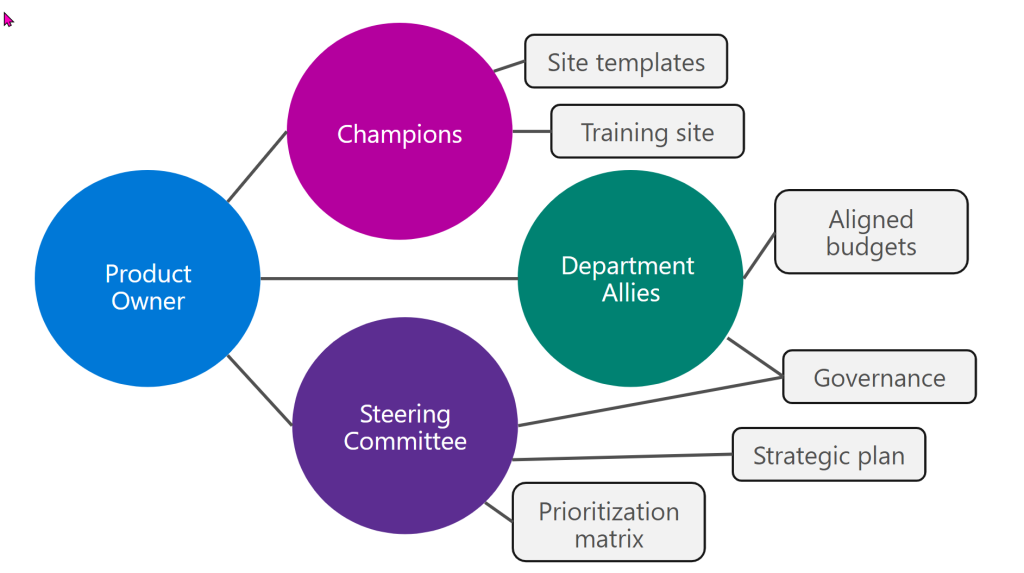Forming an Intranet Steering Committee
Do you need an intranet steering committee
As your company grows, so does the complexity of your intranet. Ultimately, the need for a steering committee will depend on your company’s size, the complexity, and your intended growth. A steering committee is essentially a group of stakeholders that can speak to the overarching company’s goals, can determine which projects are most important, and in what order each project should be tackled.
Benefits of a steering committee
Alignment
Having a solid alignment within the company/organization feeds into everything else. Your organization must have some sort of strategy. If you don’t have a clear understanding of the strategy and business needs, then your intranet may not reflect those either. For example, you may be stressed about getting people the wrong type of information. The steering committee will be senior enough to make sure what is happening is aligned with the needs of the business.
Prioritization
The steering committee will help determine what is the top of the list and what is needed to accomplish that goal.
Direction
The steering committee determines the roadmap. What are we doing when? What is the most important? What order of operations are we going to take?
Engagement
Every intranet is a living, breathing entity and therefore you need your steering committee to continue to function after your launch. For example, if someone leaves the company or changes focus, then that role in the committee needs to be filled. If you launch your intranet and nobody updates their sites and the content gets stale, you’re back in the same spot you were in before launch. The steering committee is there to help continually ensure that the intranet stays relevant, up to date, and there is guaranteed accountability and continual engagement.
Authority
If you’re looking for someone to help provide alignment, prioritization, and direction, then they also need to be the person in the company that has the power to make those types of decisions. Therefore, they also need to have authority. That is where the steering committee comes into play as they both have that authority as well as knowledge of the company’s main strategies and goals. They also have the authority to make decisions in moments of conflict, help guide those resolutions, and make tie-breaking determinations.
Communications
This can also be viewed as organizational memory. They know what worked well and what didn’t, why didn’t we proceed with a certain plan, what happened when we tried something else, etc. The intranet steering committee is what brings that organizational memory and communicates it as people come and go.
The steering committee member role
Through real life experience and knowledge, we’ve learned what types of individuals make positive and negative members of a steering committee. Those individuals who are good members: show up and follow up, are actively engaged, communicate the upsides, effectively represent their area of business (and its goals), bring vision, model desired behavior, are agents of positive change, have authority to prioritize, and decide what metrics matter. These are the qualities that you’ll want to emulate as a member of a steering committee or to look for in individuals when building a steering committee. You’ll want to steer clear of individuals who are not available/engaged, are not onboard, are contrarians, are fatalistic, have no budget, and those who are what we call “seagulls” - they swoop in, poop on everything, make a lot of noise, and fly away!

Above shows the complementary structures and roles that go with a steering committee as well as the main focuses of each. For example, a product owner or a SharePoint champion is not the same thing as a steering committee. There might be some overlap, but they have distinct roles within your intranet. Every steering committee is a group of intranet stakeholders, however not all stakeholders are a steering committee. These are good distinctions to keep in mind when building your intranet, your steering committee, and as you continue to grow and evolve.

One additional note is that when there is a request on your project list, the steering committee might not understand how complicated that is or what type of impact it will have. Our best advice for this is to take every request and put it on this priority matrix. Something may be super low effort but incredibly high impact. This matrix will help you prioritize the projects you’re working on.
All in all, your company may be small and you might not feel that a steering committee is necessary. However, remember that the cost of doing nothing provides a lack of the aforementioned benefits. A steering committee can support the goals and objectives of your intranet across the enterprise.
Resources
- Model/sample agenda for steering committee
- How to elevate Collaboration - supporting the Maturity Model for Microsoft 365 | Microsoft Docs - Steering committee mentions
- Sue Hanley’s Governance Policies & Guidelines Questions
- Sample Steering Committee Agenda
Do you have any questions for us? Continue the conversation on Twitter with the hashtag #AskSympraxis and mention @SympraxisC.